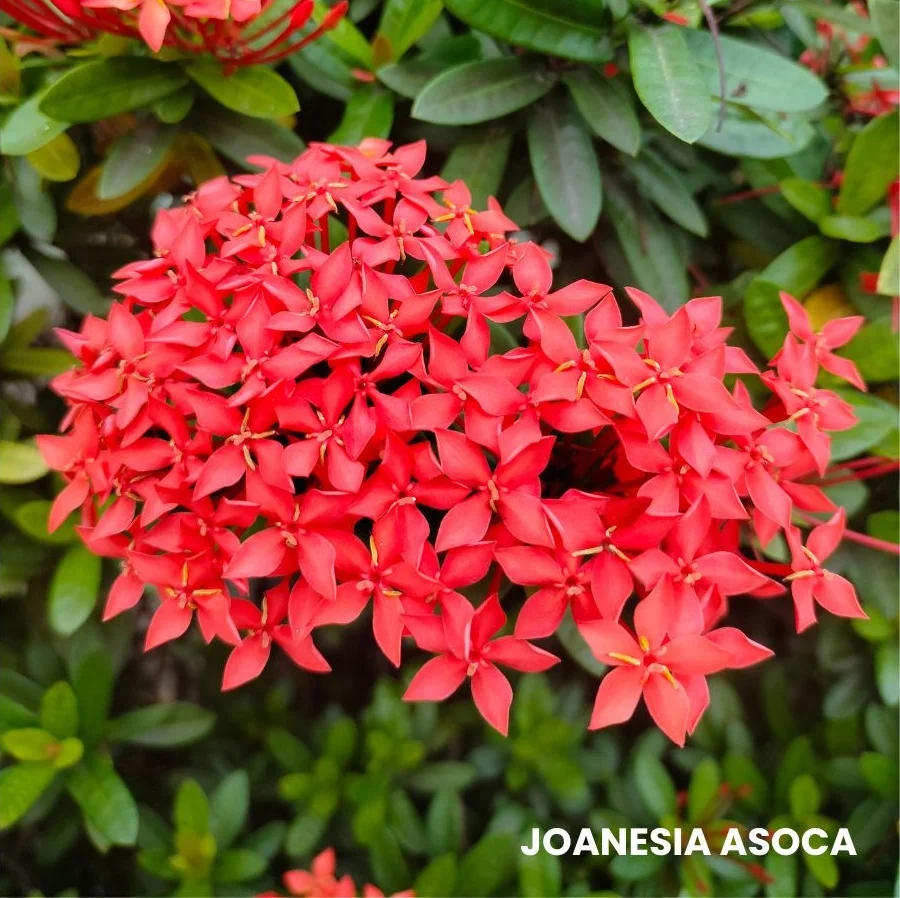Joanesia Asoca, commonly known as Jonosia Asoca, is a well-regarded remedy in homeopathic medicine, particularly for female reproductive system disorders.
It has been traditionally used in Indian medicine and introduced into homeopathy by Dr. N.D. Ray of Calcutta.
This remedy is known for its effectiveness in treating amenorrhea (absence of menstruation) and metrorrhagia (abnormal bleeding from the uterus).

SOURCE INFORMATION
Scientific Classification
- Family: Fabaceae
- Genus: Saraca
- Species: S. asoca
Common Names
- Ashoka Tree
- Sorrow-less Tree
Botanical Description
- Appearance: Joanesia Asoca is a small to medium-sized evergreen tree, often growing up to 30 feet in height. It has a spreading crown and drooping branches.
- Leaves: The leaves are compound and pinnate with 6-12 pairs of leaflets, which are oblong and have a smooth texture.
- Flowers: The flowers are bright orange to red, clustered in dense inflorescences. They have a strong fragrance and bloom in the spring.
- Fruit: The fruit is a flat, oblong pod containing several seeds.
Origin and Habitat
- Native Range: Joanesia Asoca is native to the Indian subcontinent, particularly found in the central and eastern Himalayas, and the Deccan Plateau.
- Habitat: It thrives in well-drained soil in humid and tropical regions, often found in forests and near riverbanks.
Historical Facts
- Ayurveda: In Ayurvedic medicine, the bark of the Ashoka tree has been used for centuries to treat various female reproductive issues such as menstrual irregularities, excessive bleeding, and uterine disorders. It is also used to promote overall reproductive health.
- Cultural Significance: The Ashoka tree is considered sacred in many Indian cultures and is often associated with fertility and prosperity.
Introduction to Homeopathy
- Dr. N.D. Ray: The use of Joanesia Asoca in homeopathy was introduced by Dr. N.D. Ray of Calcutta. He recognized its potential in treating gynaecological conditions and incorporated it into homeopathic practice.
DRUG PATHOGENESIS
Joanesia Asoca acts primarily on the female reproductive system, alleviating symptoms associated with menstrual irregularities, uterine pain, and related headaches.
It also addresses gastrointestinal and respiratory symptoms.
KEY CHARACTERISTICS
- Female Reproductive System: Effective in treating delayed and irregular menses, menstrual colic, amenorrhea, menorrhagia, irritable bladder, and leucorrhoea.
- Headaches: Unilateral, reflex uterine, and congestive headaches that improve in open air and with free menstrual flow.
- Gastrointestinal Symptoms: Desire for sweets and acidic foods, excessive thirst, nausea, constipation, and hemorrhoids.
- Sleep Disturbances: Disturbed sleep with dreams of traveling.
- Back Pain: Pain along the spine radiating to the abdomen and thighs.
DETAILED ORGAN SYMPTOMS
HEAD
- Headache: Unilateral, reflex uterine, and congestive headaches, better in open air and with free menstrual flow.
- Eye Pain: Pain in the eyeballs, supraorbital pains, and photophobia (sensitivity to light).
- Nasal Catarrh: Profuse, watery nasal discharge and loss of sense of smell.
GASTRIC
- Appetite: Craving for sweets and acidic foods.
- Thirst: Excessive thirst.
- Nausea: Persistent nausea.
- Constipation: Obstinate constipation and hemorrhoids.
FEMALE REPRODUCTIVE SYSTEM
- Menstrual Issues: Delayed and irregular menses, menstrual colic, amenorrhea, and menorrhagia.
- Ovarian Pain: Pain in the ovaries before the menstrual flow.
- Bladder: Irritable bladder.
- Leucorrhea: Abnormal vaginal discharge.
SLEEP
- Disturbances: Disturbed sleep with dreams of traveling.
BACK
- Pain: Pain along the spine radiating to the abdomen and thighs.
RELATIONSHIP WITH OTHER DRUGS
Compare
- Pulsatilla: Known for treating menstrual irregularities and female reproductive health issues.
- Sepia: Used for hormonal imbalances, menstrual irregularities, and uterine symptoms.
- Cimicifuga (Actaea Racemosa): Effective for menstrual cramps and menopausal symptoms.
DOSE
- Tincture: The recommended form for treating symptoms associated with female reproductive health.
Frequently Asked Questions
What conditions can Joanesia Asoca treat?
- Joanesia Asoca is primarily used for treating menstrual irregularities, amenorrhea, menorrhagia, uterine pain, and related headaches.
- It also helps with gastrointestinal and respiratory symptoms.
How is Joanesia Asoca administered?
- It is typically administered in tincture form in homeopathic practice.
Are there any side effects of Joanesia Asoca?
- When used in homeopathic doses, side effects are rare.
- However, some individuals may experience mild gastrointestinal disturbances or allergic reactions.
Meaning of Difficult Words
- Amenorrhea: The absence of menstruation.
- Metrorrhagia: Abnormal bleeding from the uterus, typically occurring at irregular intervals.
- Photophobia: Sensitivity to light, causing discomfort or pain in the eyes.
- Supraorbital: Located above the orbit (eye socket).
- Menorrhagia: Excessive menstrual bleeding.
- Leucorrhoea: Abnormal, excessive vaginal discharge.
- Colic: Severe pain in the abdomen caused by intestinal gas or obstruction in the intestines.
- Tincture: A solution where a plant or herb is dissolved in alcohol or water, commonly used in homeopathic remedies.
